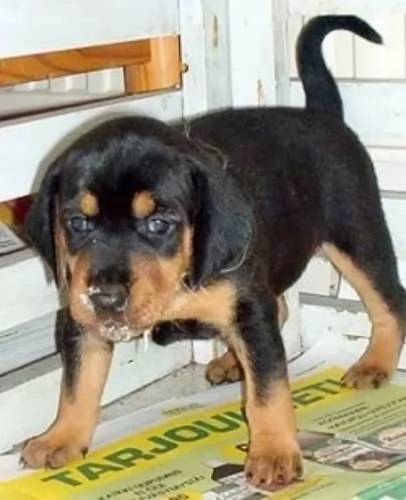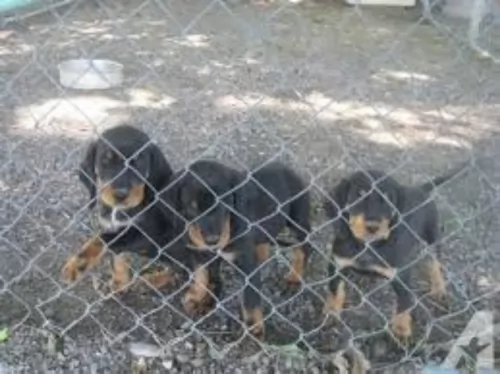 Petzlover
Petzlover Hellenic Hound is originated from Greece but Russian Toy Terrier is originated from Russia. Hellenic Hound may grow 27 cm / 11 inches higher than Russian Toy Terrier. Hellenic Hound may weigh 17 kg / 38 pounds more than Russian Toy Terrier. Both Hellenic Hound and Russian Toy Terrier has almost same life span. Both Hellenic Hound and Russian Toy Terrier has almost same litter size. Both Hellenic Hound and Russian Toy Terrier requires Low Maintenance.
Hellenic Hound is originated from Greece but Russian Toy Terrier is originated from Russia. Hellenic Hound may grow 27 cm / 11 inches higher than Russian Toy Terrier. Hellenic Hound may weigh 17 kg / 38 pounds more than Russian Toy Terrier. Both Hellenic Hound and Russian Toy Terrier has almost same life span. Both Hellenic Hound and Russian Toy Terrier has almost same litter size. Both Hellenic Hound and Russian Toy Terrier requires Low Maintenance.
 Developed in Southern Greece, the Hellenic Hound was bred to hunt hare and is an ancient breed. It is a medium sized breed with strong scent and tracking skills. It is believed to have been in existence for thousands of years. The ancestry of the breed included the Lagonikoi or laconikoi, native to southern Greece in ancient times. The breed was spread by sailors on Greece trading ships and colonization.
Developed in Southern Greece, the Hellenic Hound was bred to hunt hare and is an ancient breed. It is a medium sized breed with strong scent and tracking skills. It is believed to have been in existence for thousands of years. The ancestry of the breed included the Lagonikoi or laconikoi, native to southern Greece in ancient times. The breed was spread by sailors on Greece trading ships and colonization.
Todays Hellenic Hound is found throughout Europe. Kept somewhat isolated by the mountains, the breed was protected from outside breeding and they remained pure for centuries. It is a fearless, smart and hyped up purebred. The Hellenic Hound needs to have a job and if you don’t give him one, he will find one. He is smart and independent which sometimes makes him stubborn. It also takes this dog longer to mature than others, sometime between two and three years. It is not good for first time owners. Today’s hound is still a popular hunting dog and companion animal as well. They are rarely seen outside of the Greek country.
In 1996 the Hellenic Hound was recognized as the first Greek dog breed into the FCI. They are not recognized by the AKC. Its numbers continue to decline.
 The Russian Toy Terrier is one of the dog breeds that hails from Russia in the 20th century. The Russian nobility fancied these little dogs as companions but also as they were useful for catching rats and being watchdog.They would set off an alarm with their barking.
The Russian Toy Terrier is one of the dog breeds that hails from Russia in the 20th century. The Russian nobility fancied these little dogs as companions but also as they were useful for catching rats and being watchdog.They would set off an alarm with their barking.
It is believed that the Manchester Terrier and the English Toy Terrier were the foundation breeds for this dog.
They are available in smooth and long-haired varieties. The breed has recently been recognized by the UK Kennel Club but is not yet recognized by the American Kennel Club.
 Today’s Hellenic Hound is not a big dog but rather very average or medium. It is an athletic dog and looks like it. It has a balanced body with a deep chest and thick neck. It has medium height legs that are strong and muscular with paws that are prepared for the terrain it always works on. Its coat is short and tight. The colors of the Hellenic Hound are black with tan or white on the chest. Their heads are noble and rounded with a rectangle shaped muzzle. They have v shaped, long ears and round eyes. Their toe nails are black and so is their nose. It has excellent scent glands, very quick responses, speed and stamina. Their tail is thick and tapers off.
Today’s Hellenic Hound is not a big dog but rather very average or medium. It is an athletic dog and looks like it. It has a balanced body with a deep chest and thick neck. It has medium height legs that are strong and muscular with paws that are prepared for the terrain it always works on. Its coat is short and tight. The colors of the Hellenic Hound are black with tan or white on the chest. Their heads are noble and rounded with a rectangle shaped muzzle. They have v shaped, long ears and round eyes. Their toe nails are black and so is their nose. It has excellent scent glands, very quick responses, speed and stamina. Their tail is thick and tapers off.
 The Russian Toy Terrier is a petite dog and is inclined to be a fragile dog breed. It belongs to the toy group. It is also known as the Russian Toy Terrier or the Russkiy Toy.
The Russian Toy Terrier is a petite dog and is inclined to be a fragile dog breed. It belongs to the toy group. It is also known as the Russian Toy Terrier or the Russkiy Toy.
The dog’s small size means it is ideal for living in the city or the countryside.
He measures between just 20 and 28cm and weighs between just 1kg and 3kg.
The dog has a small head with big eyes and ears which are large ad erect. The tail was always traditionally docked to give it a cute, compact look, but these days it is left long.
You also get a long-coated dog and the smooth coated dog. The long coated variety has a lot of feathering around the tail, legs and ears. Colors of the coat can be solid red, brown and tan, black and tan or greyish and tan.
This little dog is full of character and is bold and cheerful. He is such a loyal, devoted little dog and small though he is he is territorial, protecting and guarding his owner. It is such a sociable little dog, devoted to his human family, while being wary of strangers.
Even a small dog like this will need training and socialization as he can become yappy and clingy if he is constantly piked up and petted.
 yes, they are very fond of children as long as they are carefully socialized.
yes, they are very fond of children as long as they are carefully socialized.
Great hunter, stamina ,scent, voice
He needs to have a yard or land. He doesn’t do well in apartments.
The breed is very intelligent and can be very trainable. However, they can also be stubborn and that makes training harder.
 The Russian Toy is a small, feisty dog with long legs and huge upright ears. He is intelligent too. Don't let his fine structure deceive you as he is far more robust and tough than he looks.
The Russian Toy is a small, feisty dog with long legs and huge upright ears. He is intelligent too. Don't let his fine structure deceive you as he is far more robust and tough than he looks.
He is a great playmate for disciplined, respectful children who know how to be kind to animals. Wild, unruly kids could so easily accidentally break one of his tiny little legs during rough play.
He loves his human family though and is guaranteed to make you an excellent little pet and companion.
 The Hellenic Hound is a fairly healthy breed having been isolated on the Island of Greece for the most part. They are susceptible to:
The Hellenic Hound is a fairly healthy breed having been isolated on the Island of Greece for the most part. They are susceptible to:
Could be hips, elbows or knees. If untreated can lead to lameness or inability to walk.
Causes joint pain and can cause lameness or inability to walk.
Can be fatal if not treated immediately. To avoid it don’t feed a large meal before or after exercise.
Can be a variety of things that occur during the hunt.
Need to keep the ears clean and dry in order to avoid infections.
 There isn’t too much information about inherited health problems with this dog and he can live to be 11, 12 or 13 years of age, maybe even longer.There are one or two health problems to be aware of -
There isn’t too much information about inherited health problems with this dog and he can live to be 11, 12 or 13 years of age, maybe even longer.There are one or two health problems to be aware of -
This condition occurs with the knee caps of the dog and either one or both back legs can be affected. Sometimes surgery will be required to help the dog.
Little dogs always battle with their teeth, and the Russian Toy Terrier can experience problems when the puppy or ‘milk’ teeth don’t fall out. It affects the development of adult teeth. Sometimes the vet even has to have the teeth removed.
 Feed the puppy 2-3 times a day a total of 2 cups
Feed the puppy 2-3 times a day a total of 2 cups
Feed the adult twice a day a total of 2-3 cups
The Hellenic Hound has excellent stamina, speed and scenting ability.
This is a very active, athletic dog that needs to work and needs exercise. He is powerful, quick and has great endurance. It thrives on hunting but will need other activities on the days it doesn’t hunt. It needs a yard or land to play in. Agility, Field Trials, tracking, hunting and fly ball are all activities the Hellenic Hound will enjoy.
 The Russian Toy Terrier is a small breed and isn’t going to need too much exercise. However it will do him good to get out to sniff around, and a walk every day will be recommended.
The Russian Toy Terrier is a small breed and isn’t going to need too much exercise. However it will do him good to get out to sniff around, and a walk every day will be recommended.
Your Russian Toy Terrier is a fairly low maintenance dog and isn’t going to require specialist grooming. The little dog will simply require some occasional brushing to remove loose hair.
When you brush him, check inside his mouth for bad teeth as small dogs like this can suffer from pain with overcrowding of teeth.
Tiny though he is, the Russian Toy Terrier will need good food. It will be tempting to pop sugary treats into such a tiny little dog’s mouth. This can in fact be seriously dangerous for him, not to mention that he can become obese. This opens up anew set of health problems.
You can feed this little dog commercially manufactured food but it should be the best quality one for small breeds.
Give him some tasty homemade food too. Simply add into one big pot chicken, brown rice or pasta and spinach, sweet potatoes and carrots. This food can all be chopped up, refrigerated and added warmed up and in small portions to your tiny pets dry kibble once or twice a week.
A tiny bit of raw meat can also go a long way to ensuring his skin stays healthy and free of skin infections.
Ensure that there is always a bowl of fresh, cool water within his reach.